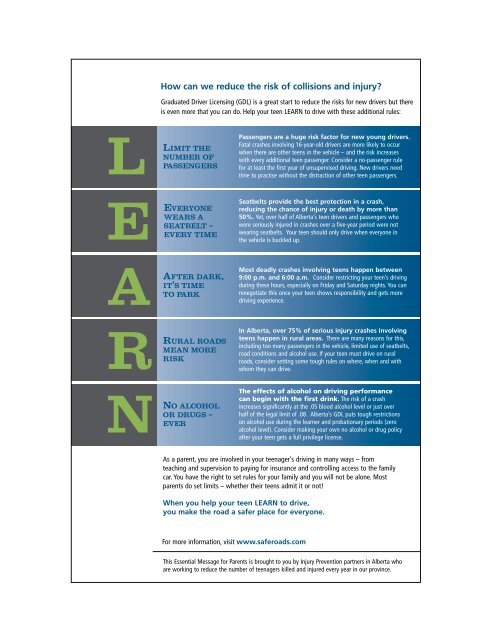Geared to Go A Workbook for Coaching New Drivers
Geared to Go A Workbook for Coaching New Drivers
Geared to Go A Workbook for Coaching New Drivers
You also want an ePaper? Increase the reach of your titles
YUMPU automatically turns print PDFs into web optimized ePapers that Google loves.
How can we reduce the risk of collisions and injury?Graduated Driver Licensing (GDL) is a great start <strong>to</strong> reduce the risks <strong>for</strong> new drivers but thereis even more that you can do. Help your teen LEARN <strong>to</strong> drive with these additional rules:LEARNLimit t h en u m b e r o fpa s s e n g e r sEv e ry o n ew e a r s as e at b e lt –e v e ry t i m eAf t e r d a r k,it’s t i m et o pa r kRu r a l r o a d sm e a n m o r er i s kNo a l c o h o lo r d r u g s –e v e rPassengers are a huge risk fac<strong>to</strong>r <strong>for</strong> new young drivers.Fatal crashes involving 16-year-old drivers are more likely <strong>to</strong> occurwhen there are other teens in the vehicle – and the risk increaseswith every additional teen passenger. Consider a no-passenger rule<strong>for</strong> at least the first year of unsupervised driving. <strong>New</strong> drivers needtime <strong>to</strong> practise without the distraction of other teen passengers.Seatbelts provide the best protection in a crash,reducing the chance of injury or death by more than50%. Yet, over half of Alberta’s teen drivers and passengers whowere seriously injured in crashes over a five-year period were notwearing seatbelts. Your teen should only drive when everyone inthe vehicle is buckled up.Most deadly crashes involving teens happen between9:00 p.m. and 6:00 a.m. Consider restricting your teen’s drivingduring these hours, especially on Friday and Saturday nights. You canrenegotiate this once your teen shows responsibility and gets moredriving experience.In Alberta, over 75% of serious injury crashes involvingteens happen in rural areas. There are many reasons <strong>for</strong> this,including <strong>to</strong>o many passengers in the vehicle, limited use of seatbelts,road conditions and alcohol use. If your teen must drive on ruralroads, consider setting some <strong>to</strong>ugh rules on where, when and withwhom they can drive.The effects of alcohol on driving per<strong>for</strong>mancecan begin with the first drink. The risk of a crashincreases significantly at the .05 blood alcohol level or just overhalf of the legal limit of .08. Alberta’s GDL puts <strong>to</strong>ugh restrictionson alcohol use during the learner and probationary periods (zeroalcohol level). Consider making your own no alcohol or drug policyafter your teen gets a full privilege license.As a parent, you are involved in your teenager’s driving in many ways – fromteaching and supervision <strong>to</strong> paying <strong>for</strong> insurance and controlling access <strong>to</strong> the familycar. You have the right <strong>to</strong> set rules <strong>for</strong> your family and you will not be alone. Mostparents do set limits – whether their teens admit it or not!When you help your teen LEARN <strong>to</strong> drive,you make the road a safer place <strong>for</strong> everyone.For more in<strong>for</strong>mation, visit www.saferoads.comThis Essential Message <strong>for</strong> Parents is brought <strong>to</strong> you by Injury Prevention partners in Alberta whoare working <strong>to</strong> reduce the number of teenagers killed and injured every year in our province.




